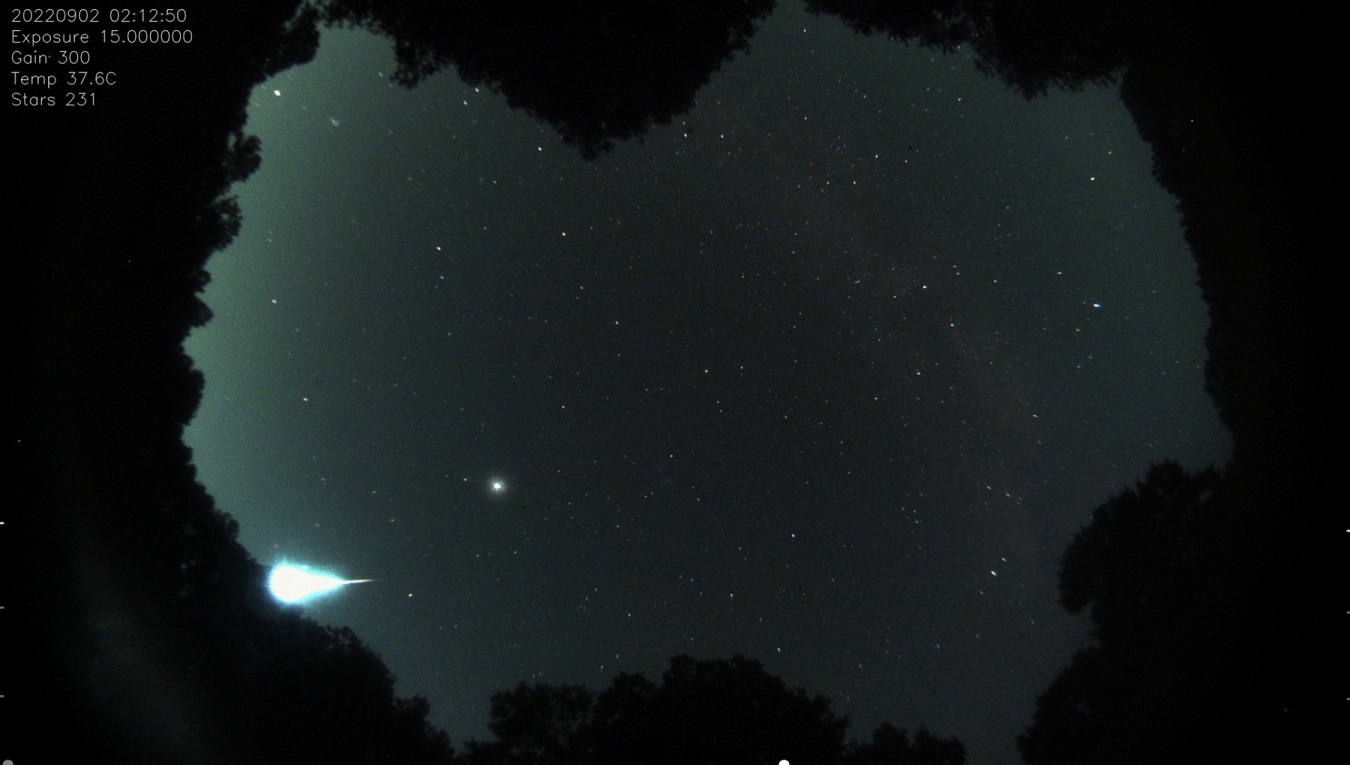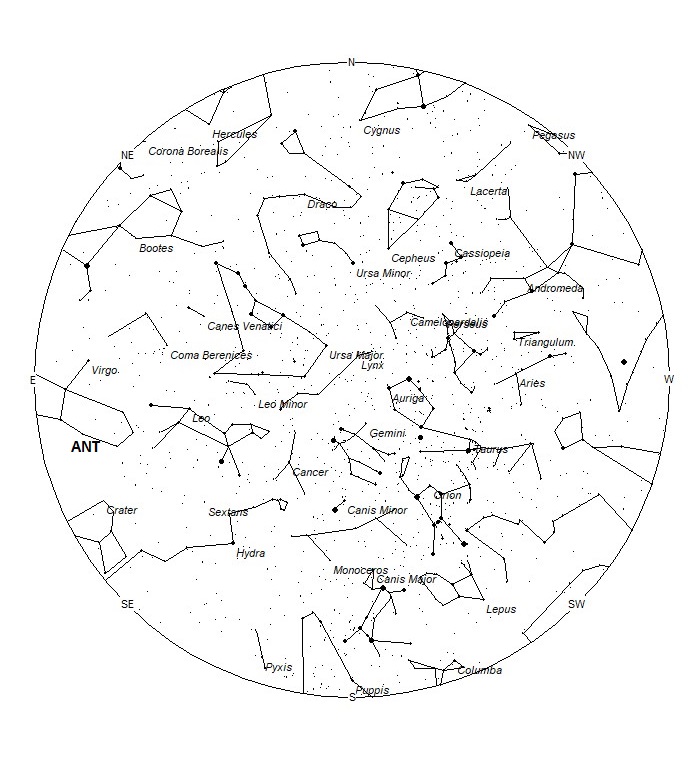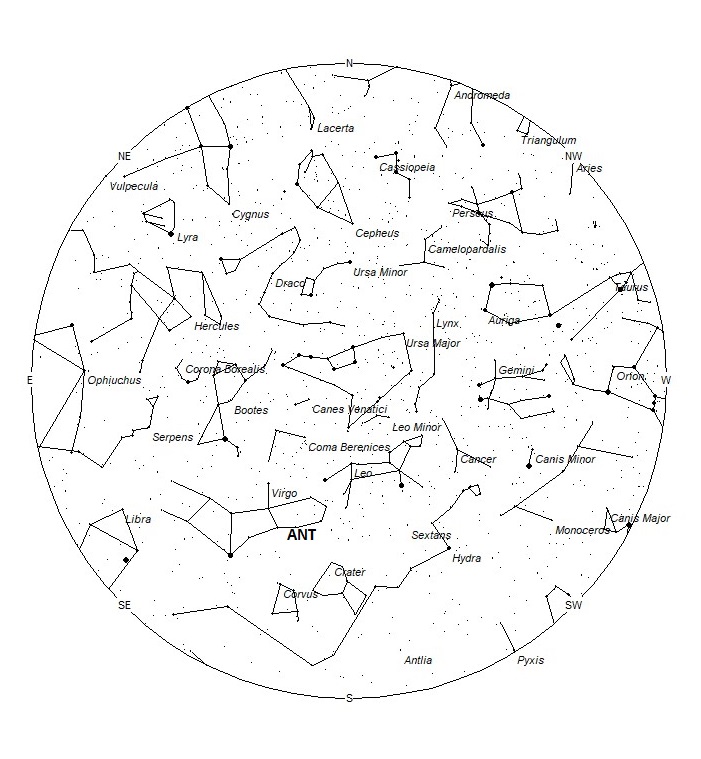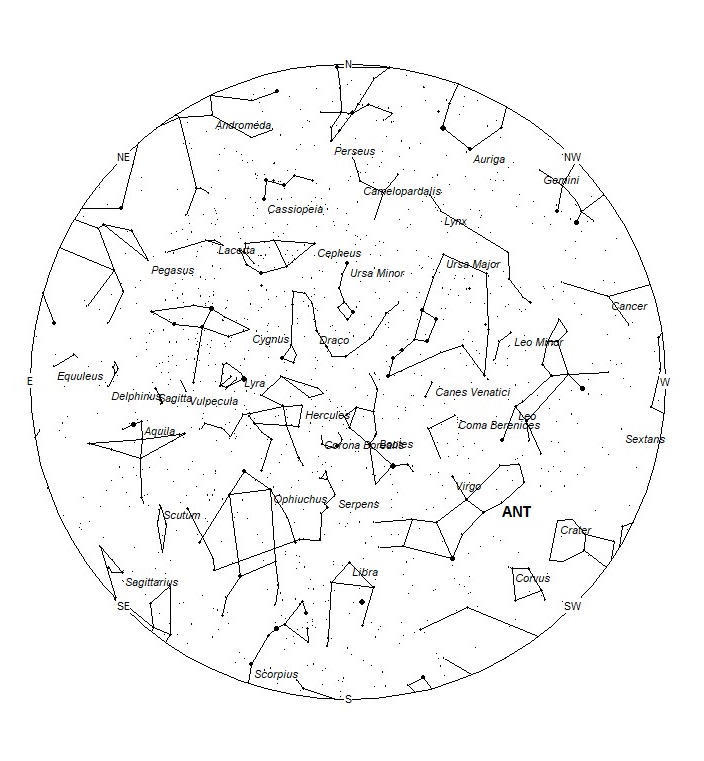 Aaron Morris captured this bright fireball just above the horizon on September 2, 2022, at 02:12 EDT (6:12 UT) from Griffin, Georgia, USA. The bright object above the fireball is the planet Jupiter. For more information on this event visit: https://fireball.imo.net/members/imo_view/event/2022/5786 ©Aaron Morris
Aaron Morris captured this bright fireball just above the horizon on September 2, 2022, at 02:12 EDT (6:12 UT) from Griffin, Georgia, USA. The bright object above the fireball is the planet Jupiter. For more information on this event visit: https://fireball.imo.net/members/imo_view/event/2022/5786 ©Aaron MorrisDuring this period, the moon reaches its last quarter phase on Wednesday March 15th. At that time the moon will lie 90 degrees west of the sun and will rise near 0300 local standard time (LST). This weekend the waning gibbous moon will rise near midnight and will spoil the night sky the remainder of the night. Even with the moon below the horizon during the early evening hours, meteor activity this time of year is very low. The estimated total hourly rates for evening observers this week should be near 3 as seen from mid-northern latitudes (45N) and 4 as seen from tropical southern locations (25S) For morning observers, the estimated total hourly rates should be near 6 as seen from mid-northern latitudes (45N) and 11 as seen from tropical southern locations (25S). The actual rates seen will also depend on factors such as personal light and motion perception, local weather conditions, alertness, and experience in watching meteor activity. Morning rates are reduced during this period due to moonlight. Note that the hourly rates listed below are estimates as viewed from dark sky sites away from urban light sources. Observers viewing from urban areas will see less activity as only the brighter meteors will be visible from such locations.
The radiant (the area of the sky where meteors appear to shoot from) positions and rates listed below are exact for Saturday night/Sunday morning March 11/12. These positions do not change greatly day to day so the listed coordinates may be used during this entire period. Most star atlases (available at science stores and planetariums) will provide maps with grid lines of the celestial coordinates so that you may find out exactly where these positions are located in the sky. I have also included charts of the sky that display the radiant positions for evening, midnight, and morning. The center of each chart is the sky directly overhead at the appropriate hour. These charts are oriented for facing south but can be used for any direction by rotating the charts to the desired direction. A planisphere or computer planetarium program is also useful in showing the sky at any time of night on any date of the year. Activity from each radiant is best seen when it is positioned highest in the sky, either due north or south along the meridian, depending on your latitude. It must be remembered that meteor activity is rarely seen at the radiant position. Rather they shoot outwards from the radiant, so it is best to center your field of view so that the radiant lies at the edge and not the center. Viewing there will allow you to easily trace the path of each meteor back to the radiant (if it is a shower member) or in another direction if it is sporadic. Meteor activity is not seen from radiants that are located far below the horizon. The positions below are listed in a west to east manner in order of right ascension (celestial longitude). The positions listed first are located further west therefore are accessible earlier in the night while those listed further down the list rise later in the night.
These sources of meteoric activity are expected to be active this week.
.
The large Anthelion (ANT) radiant is currently centered at 12:16 (184) -03. This position lies in west-central Virgo, 1 degree southwest of the 4th magnitude star known as Zaniah (eta Virginis Aa). Due to the large size of this radiant, these meteors may also be seen from eastern Leo as well as Virgo. This radiant is best placed near 01:00 local standard time (LST) when it lies on the meridian and is highest in the southern sky. Rates at this time should be near 2 per hour no matter your location. With an entry velocity of 30 km/sec., the average Anthelion meteor would be of slow velocity.
The gamma Normids (GNO) are an ill-defined source, only well seen from the Southern Hemisphere. Some sources dispute its existence while others have differing activity periods in March. Here we list the parameters from the International Meteor Organization*. They list the activity period is from February 25 through March 28, with maximum activity occurring on March 14. At maximum, the radiant is located at 15:56 (239) -50. This area of the sky lies in central Norma, 1 degree southwest of the faint star known as eta Normae. These meteors are best seen during the last dark hour before dawn, when the radiant lies highest in the southern sky. With an entry velocity of 56km/sec., the average meteor from this source would be of medium-fast velocity. Zenith hourly rates are listed as 6 at maximum, but I believe this is overly optimistic. *Jürgen Rendtel, 2023 Meteor Shower Calendar, Page 5, https://www.imo.net/files/meteor-shower/cal2023.pdf
As seen from the mid-northern hemisphere (45N) one would expect to see approximately 4 sporadic meteors per hour during the last hour before dawn as seen from rural observing sites. Evening rates would be near 2 per hour. As seen from the tropical southern latitudes (25S), morning rates would be near 8 per hour as seen from rural observing sites and 3 per hour during the evening hours. Rates are reduced by bright moonlight during this period.
You can keep track of the activity of these meteor showers as well as those beyond the limits of visual observing by visiting the NASA Meteor Shower Portal. You can move the sky globe to see different areas of the sky. Colored dots indicate shower meteors while white dots indicate sporadic (random) activity. The large orange disk indicates the position of the sun so little activity will be seen in that area of the sky.
The list below offers the information in tabular form of the showers that I feel are within reach of the visual observer to discern. Hourly rates are often less than 1 but noting parameters such as the radiant distance and the elevation of each meteor, one can compute the probability of shower association. Most showers discovered by video means have rates less than 1 per night away from maximum, so the showers listed in these outlooks are not as weak as they seem. Rates and positions are exact for Saturday night/Sunday morning except where noted in the shower descriptions.
| SHOWER | DATE OF MAXIMUM ACTIVITY | CELESTIAL POSITION | ENTRY VELOCITY | CULMINATION | HOURLY RATE | CLASS |
| RA (RA in Deg.) DEC | Km/Sec | Local Standard Time | North-South | |||
| Anthelions (ANT) | – | 12:16 (184) -03 | 30 | 01:00 | 2 – 2 | II |
| gamma Normids (GNO) | Mar 14 | 15:56 (239) -50 | 56 | 05:00 | <1 – <1 | IV |
Class Explanation: A scale to group meteor showers by their intensity:
- Class I: the strongest annual showers with Zenith Hourly Rates normally ten or better.
- Class II: reliable minor showers with ZHR’s normally two to ten.
- Class III: showers that do not provide annual activity. These showers are rarely active yet have the potential to produce a major display on occasion.
- Class IV: weak minor showers with ZHR’s rarely exceeding two. The study of these showers is best left to experienced observers who use plotting and angular velocity estimates to determine shower association. These weak showers are also good targets for video and photographic work. Observers with less experience are urged to limit their shower associations to showers with a rating of I to III.







 You saw something bright and fast? Like a huge shooting star? Report it: it may be a fireball.
You saw something bright and fast? Like a huge shooting star? Report it: it may be a fireball.  You counted meteors last night? Share your results with us!
You counted meteors last night? Share your results with us!  You took a photo of a meteor or fireball? You have a screenshot of your cam? Share it with us!
You took a photo of a meteor or fireball? You have a screenshot of your cam? Share it with us!  You caught a meteor or fireball on video? Share your video with us!
You caught a meteor or fireball on video? Share your video with us!